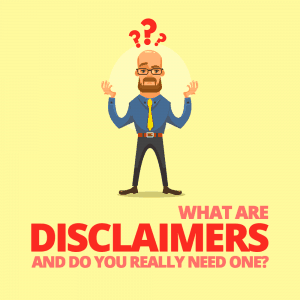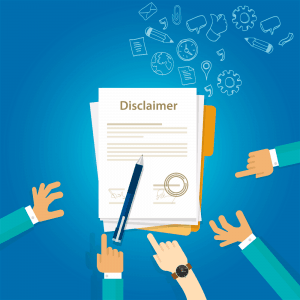
Of course you have—signs like these are everywhere and we come across them almost daily as we go about our lives. And when we see them, we take extra care so as to not run afoul of the warnings they put forth.
But what are these signs really saying? Are the people who use them just altruistically concerned about your health and well-being?
Sadly, the answer is: probably not.
The reality is that these signs are basic forms of disclaimers, and the people that put them up are merely trying to protect themselves from legal liability in the event that the worst happens.
But these signs don’t look or feel like the types of legalese-ridden documents we’re used to seeing in the footers and menus of every website and mobile app we come across.
So what’s the difference—and why is everyone so worried about lawsuits and liability?
Whether you’re a developer who works as a freelancer or one who runs your own business, you’re probably an honest person—and you almost certainly don’t need a sign on your property warning of a dangerous dog—so do you really even need a disclaimer on your site?
Unfortunately, the answer isn’t black and white, and to truly understand whether or not your website or the mobile app you’ve created needs one, you have to first understand what disclaimers are and what they can actually do for you.
Below, I’ve comprehensively outlined what disclaimers are and the reasons why your website or mobile app may need one. But let me note that, although I consult with developers to tailor legal policies for their apps, I am not a lawyer. And while these considerations are crucial for your mobile app or online business, it’s important to seek legal counsel from actual legal professionals.
What Is a Disclaimer?
A disclaimer is merely a statement that is intended to limit the legal liability and/or obligation of the person or entity that displays it. The length and complexity of this statement depends entirely on the products, services, content, and functionality that the small business owner provides.
Basically, the more complex a business, service, or software program is, the longer and more comprehensive its disclaimer needs to be.
It should clearly identify certain aspects of your business or services that could be misunderstood or misconstrued by your customers or clients as being something that they are not—and state that you are not liable for such misunderstandings.
Take other industries, for example. Lawyers, physicians, dietitians, and other professionals must be particularly cautious with the content they publish, as it can be misconstrued and taken as professional advice. Of course, this kind of advice can only be properly given with the appropriate, privileged disclosures.
While people may feel confident in the information provided by a given website, those who act based on it—especially if there is a disclaimer stating it is not professional advice—do so irresponsibly and at their own risk.
A disclaimer warns readers that website content is for informational purposes only, and that users should not act on the information they read there or interpret it as actionable advice. Depending on your niche or the services you provide, your website will need specific disclaimers to protect you from civil liability and to meet regulations that might be specific to your industry.
Marketing your business online—whether you work in software development, provide services as a freelancer or consultant, or simply run a niche blog about software development—comes with unique risks, and one of them is the potential for legal liability. Disclaimers are one of the defensive weapons in your digital arsenal that help protect you from lawsuits and liability. Every business, website, and piece of software needs a disclaimer—regardless of complexity—if for no other reason than to protect yourself from liability for any errors in your content or service.
But before you go off building your policy with one of those online disclaimer generators, you need to understand what they do for you and which specific aspects of your software, services, or online business need one.
How Do Disclaimers Help You?

Anyone who accesses your site, uses your software, or takes advantage of the services you provide will be able to see your policies and understand the potential risks of continued patronage. They will also be deterred from taking legal action against you, not only as a result of being warned about the risks in the disclaimer, but also due to the language that indemnifies you from liability for certain things.
While you can include your disclaimer within a comprehensive terms and conditions section, both are extremely important documents worthy of their own pages. Additionally, a standalone disclaimer is more likely to be upheld in court, as it is more likely to be seen, accessed, and understood by visitors to your site.
To fully protect yourself, your disclaimers must encompass all identifiable areas of potential risk. Some concerns to address in your disclaimer include:
- Third-party responsibility—If you allow ads on your site, user content submissions, comments on your blog, or any other form of third-party content, including a disclaimer that covers actions, inactions, or errors by those third parties can safeguard your business.
- Ownership of content—Content that is wholly yours and that you wrote or paid for should be recognized in a disclaimer to help protect you from theft of the content, and accusations that the content was copied or stolen.
- Accuracy of content—Even unintentional errors in the content of your website could expose your business to legal liability. By publishing a disclaimer that you do not guarantee the accuracy of the information on your website, you’ll shield yourself from a modicum of risk and exposure.
- Physical liability—If you provide a mobile app, software as a service (SaaS), or software of any type, including a disclaimer that outlines the fact that you are not liable for any flaws in the software or any physical damages it may cause to the user’s machine or their data is essential. This disclaimer should also indicate that you are not responsible for any misuse of the software by the user.
What Are Some Common Disclaimers?
Here are some types of disclaimers to consider for your online business:
Testimonial
These disclaimers spell out that testimonials and reviews on your site are not guarantees and don’t reflect how everyone will experience the product, service, or results. The Federal Trade Commission (FTC) dictates that if you include testimonials or reviews on your site—paid or otherwise—you must also provide a disclaimer that states that user experiences may vary from those depicted in the testimonials.
Affiliate
If you have any affiliate relationships—either inbound or outbound—they must be disclosed in a conspicuous location on your website pursuant to FTC regulations. You must disclose not only the fact that you engage in such relationships, but also that you stand to profit from them and your users’ interactions with your site.
Legal
For those websites that have content related to legal matters, this disclaimer demonstrates that you’re providing general information only, and that it shouldn’t be construed as actual legal advice. Attorney websites and other legal sites may need extensive disclaimers to address these issues.
Health, Fitness, and Medical

As with health disclaimers, these should go on the websites of physicians, ancillary providers, and medical-related blogs, and are very similar, except for the fact that they pertain specifically to medical as opposed to health-related content. By stating that the content is for educational purposes only, you will limit your liability in the event that a user acts on the information on your site and experiences negative effects.
Fitness disclaimers are also like medical and health disclaimers, in that they express that the content of your website is for informational and educational purposes only, and should not be taken as professional fitness advice. These can be used by gyms, personal trainers, physicians, physical therapists, and any business that deals with health and fitness.
External Links
This type of disclaimer limits liability related to any links that go out to third-party sites and content from the pages, blogs, or ads on your site. It lets visitors to your website know that you’re not responsible for the content on the websites directed to by those external links, nor are you responsible for the legitimacy of those sites or the accuracy of their content.
Email disclaimers should be relevant to your niche, and some are mandated by law—specifically CAN-SPAM and Canada’s Anti-Spam Legislation—depending on the nature of your business. These can cover confidentiality, viruses, employer liability, misstatements, and more. These disclaimers should address your business’s use of marketing emails such as newsletters, and also emphasize the fact that participation in such communication is optional. An extension of email disclaimers is the inclusion of text that describes why the user is receiving the email, along with an “unsubscribe” button at the bottom.
Professional
Much like medical and health disclaimers, this type of disclaimer is a general warning that your website doesn’t contain actual recommendations and is in no way a substitute for seeking legitimate, professional advice.
Do You Need a Disclaimer?
There is a wide variety of disclaimers and clauses to consider for your software, freelancing service, or website. You may need just one, or you may need a combination of several to protect yourself fully from potential liability. While some might be recommended for inclusion by your attorney, others might actually be mandated by law depending on the content of your site.
Specifically, as a developer, you need to include a disclaimer that details the fact that your software, app, or SaaS is available as is, meaning that you are under no obligation to provide enhancements, updates, or support. While you are more than welcome to provide these things, having such a disclaimer in place will protect your position regardless of your business decisions.
You should also ensure that any emails automatically sent to your users include a disclaimer that states the reason why they are receiving the email, and an unsubscribe option. This is a legal requirement according to the CAN-SPAM Act.
If you do work as a freelancer or consultant, you will need to ensure that your website has the proper disclaimers in place to protect against liability for errors in your content. You will also need to disclaim your responsibility for the content of your site, while also stating that the information provided is for educational use only. If you include testimonials on your site, you will need to post a disclaimer stating that the experiences depicted in the testimonials are not typical, and will not necessarily reflect the experience of the average user.
Although a disclaimer is not always a legal necessity for software developers, it is never going to hurt to have one. Considering the recent data breaches and outcry over information privacy and data controller responsibility, including a disclaimer as an added layer of protection to safeguard your position is now a wiser choice than ever.
Better Safe Than Sorry: Include a Disclaimer
Websites without disclaimers are wide open to potential liability.
The best place to start is to self-assess your risk exposure by considering who visits your site and how they might use the information you present. The areas of risk you identify should guide you through your choices of disclaimers to include and the details they’ll encompass.
If you’re unsure what your areas of risk are or you’re unable to assess the risk yourself, consider consulting an attorney to discuss risk assessment—even if you don’t use the lawyer to draft your disclaimers. A risk consultation could be relatively low-cost and might even be part of a free or cut-price consultation with an attorney hoping to win your business.
Either way, the costs of a consultation pale in comparison to the potential costs of legal challenges down the road.
Even though the software and services you provide are trustworthy and safe—and you don’t have a slippery floor or a feral dog—there is always risk involved with conducting business in software development, and a comprehensive disclaimer can go a long way toward mitigating that risk and safeguarding your investment.
